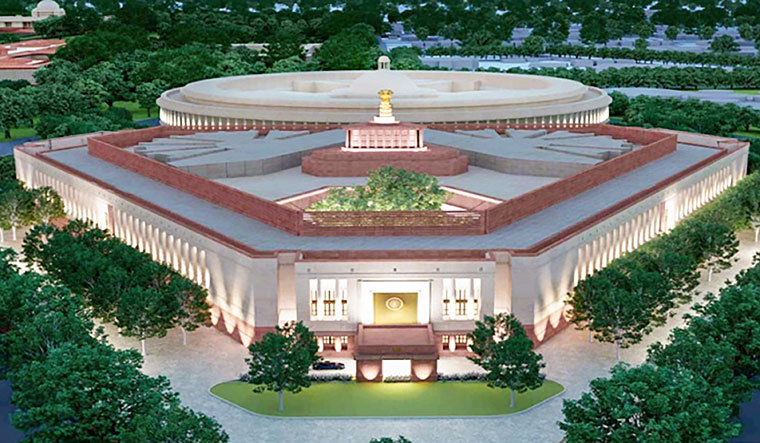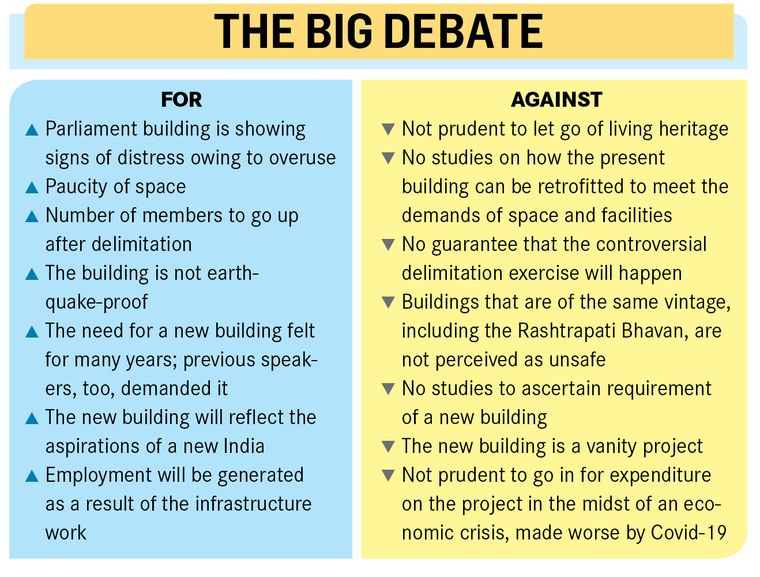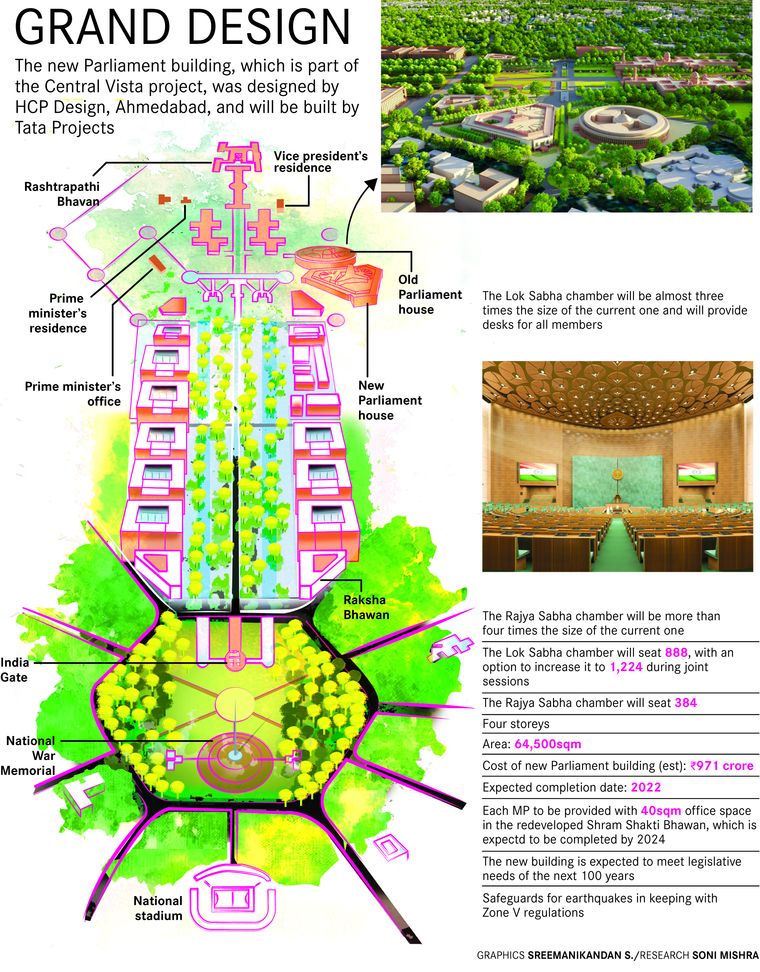Sir Herbert Baker, the architect of the Parliament house, had originally envisaged a triangular structure. But Sir Edwin Lutyens, who designed New Delhi, proposed a circular design and prevailed upon his junior to alter the plan. And thus was built the Colosseum-like building, said to have been inspired by the Chausath Yogini Temple in Madhya Pradesh. Then, in 1928, just a year after the building was inaugurated, Lutyens conceptualised a mirror image of it to be constructed at a stone’s throw from the original structure to house the secretariat of the then Council House.
Over nine decades later, as the designs of the new Parliament house, envisioned as a triangular edifice, were unveiled and the foundation of the structure laid by Prime Minister Narendra Modi, the throwback to the past was unmistakable. In its vision and scope though, it is a break from the old and seeks to represent, in Modi’s words, the aspirations of a new India, even as the proposed Parliament building and the Central Vista Project that it is a part of have been mired in controversy. Questions abound with regard to the concept, intent and the procedures adopted. There are also allegations that it is guided by political agenda.
The new Parliament house is grand in scale. A 64,500sqm, four-storey building, it will seat 888 members in the Lok Sabha chamber, with an option to increase it to 1,224 seats during joint sessions. The Rajya Sabha chamber will seat 384. To be built at an estimated cost of Rs971 crore, it is scheduled to be ready in time to commemorate India’s 75th Independence Day in 2022.
HCP Design, Planning and Management, the design consultant for the project, said the architecture of the new building is similar to the present one but does not mimic it. “It emerges from the logic and exigencies of modern construction. The architectural strategy is to harmonise the two buildings such that they work in conjunction,” the firm said in an e-mail response.
The building, as per HCP, will take reference from the present structure and other buildings of the Central Vista, and the classical, folk and tribal arts and crafts of India. The Lok Sabha and the Rajya Sabha interiors will have reference to the national bird and flower respectively and the national emblem will crown the new Parliament house. HCP said the plot on which the new building is proposed is triangular in shape, therefore a triangular building makes the best use of the available space.
The ruling dispensation insists that there is an imperative need for a new building since the present structure is unable to cope with the growing demands of space, amenities, security arrangements and technology. The Lok Sabha Secretariat, in a statement, said that there were not enough seats for members; during joint sessions, temporary seats had to be arranged in the aisles. Also, being a heritage building, there was difficulty in meeting fire safety norms, and the electrical, air-conditioning and plumbing systems were proving to be costly to operate and maintain, it said. The building did not conform with the requirements of Zone V seismic vulnerability, it pointed out. Another argument in support of a new building is that the number of members will increase when a delimitation exercise is carried out, and the present building will not be able to accommodate the additional members.
“We kept making changes in the Parliament building to meet the growing demands in terms of creating more space and facilities,” said Lok Sabha Speaker Om Birla. “At first, it was a single-storey building, then it became two and finally three floors. Due to the alterations carried out, the basic nature of the building also changed. The need for a new Parliament has been felt for many years now.”
However, experts opposed to the project are not convinced about the need for a new building. “No study has been carried out with a view to retrofitting or making adaptive reuse of the Parliament building, which is a norm for all buildings all over the world,” said Lt Col Anuj Srivastava (retired), an architect from the School of Planning and Architecture, Delhi. “Several parliament buildings internationally are much older. This building is less than 100 years old. It is not enough to just say that we are running out of space and hence we will build a new Parliament.”
According to the Lok Sabha Secretariat, the custodian of the building, studies undertaken by various agencies have pointed out that the building will have to be vacated for 18-24 months to carry out structural retrofitting, relaying of electrical and mechanical services and air-conditioning. “The need for a new Parliament building was recognised by previous speakers, too, who sent their proposals to the government for a new Parliament house to be constructed,” said Birla.
In 2016, then Lok Sabha speaker Sumitra Mahajan had written to the Union urban development ministry, proposing the need for a new Parliament house. Her predecessor Meira Kumar had said that the building was “weeping” from overuse and structural deterioration. Her proposal for a new building had, however, run into opposition from the left parties.
Srivastava, who is one of the petitioners in the Supreme Court against the project, questioned the delimitation argument. He said the exercise was caught in a debate as it was seen as rewarding states with a poor record in population control. “There is no confirmation on when and if at all the delimitation exercise will be undertaken,” he said. “In 2001, the exercise was put off for 25 years. Also, according to the Economic Survey, the population of India will start declining in 2061. So do we really need this huge building?”
The criticism is that the Rs20,000 crore Central Vista Project is being carried out without adequate public consultation or discussion with experts or a parliamentary debate. Birla, however, said that all stakeholders were consulted. “A proposal for the new Parliament building was made by the presiding officers in both houses of Parliament, after which it was taken up by the general purposes committee, in which leaders of different political parties and chairpersons of parliamentary committees are present,” he said.
There is outrage over the project getting cleared during the Covid-19 lockdown—the Central Vista Committee, in an online meeting on April 23, cleared the new Parliament building. The decision was taken in the absence of the panel’s non-governmental members, including representatives of The Indian Institute of Architects and the Institute of Town Planners, India.
Balbir Verma, who represents The Indian Institute of Architects in the committee, said, “We, the non-governmental members, sent a letter seeking a postponement of the meeting. But the government went ahead with it. We received the minutes of the meeting, but we could not raise objections. How could we? We had not seen the plan. We were not present in the meeting.”
Verma said that at the very start, experts had raised the issue of flawed criteria for selecting the design consultant. Instead of an open competition, as has been the norm, a procedure akin to a tender was adopted, and there were six competitors. “There ought to have been an open design competition on the lines of what was done for the National War Memorial or the Indira Gandhi National Centre for the Arts,” said Verma. “And the criteria were flawed. It was how much was their financial turnover. How can you have a financial criterion while selecting a design?”
According to Rajeev Suri, a petitioner in the Supreme Court against the project, the procedural requirements for an environment impact assessment have been flouted by the government. As per the rules, there should have been a cumulative impact assessment for the entire project. “However, the impact assessment was done only for the Parliament [house] and approval sought in a piecemeal manner,” he said. “The assessment, as per the rules, should have been conducted by the state government and not the Centre. Also, the expert advisory committee took over the role of appraiser and cleared the project.”
Suri said that there were grave concerns with regard to the impact on the ecosystem of the area. “The trees in the area are home to a number of birds and other creatures,” he said. “We moved an urgent application in the Supreme Court, and it took cognisance of the uprooting of trees for the project. But the damage was done by then. As many as 404 trees had been uprooted.”
The Central Vista Project has been criticised for seeking to alter the historical character of New Delhi. “This is how India and the world knows New Delhi,” said historian Sohail Hashmi. “When people outside of India think of us, two images that come to their minds are the Taj Mahal and then the Rashtrapati Bhavan and the two secretariat buildings. This is the profile of Delhi. You are going to do away with it without any consultation.” HCP, however, said that none of the original Lutyens and other key buildings would be demolished.
The project, it is alleged, is driven by a political agenda—that of Modi’s desire to leave his imprint on New Delhi, and in the process obliterate signs of the erstwhile dominance of the Nehru-Gandhis on the country’s power dynamics. His critics say it is a ‘vanity project’, with Congress leader Jairam Ramesh describing it as “Modi Mahals”. They say that the government’s priorities are misplaced, and it is heartless to spend so much on the project at a time when the country is going through an economic recession and fighting the Covid-19 pandemic. The timing of the bhoomi pujan for the new Parliament building was also not lost on his opponents, coming as it did amid a raging farmers’ protest.
“The act of laying the foundation stone of a Rs971 crore Parliament building is equal to opening a cake shop after snatching the bread of the farmers,” said Congress’s Jaiveer Shergill. “At a time when the country is going through an economic recession and dealing with a pandemic, public money is being spent on constructing buildings merely to satisfy the government’s ego.”
This journey from the old to the new is ambitious, yet deeply controversial.





